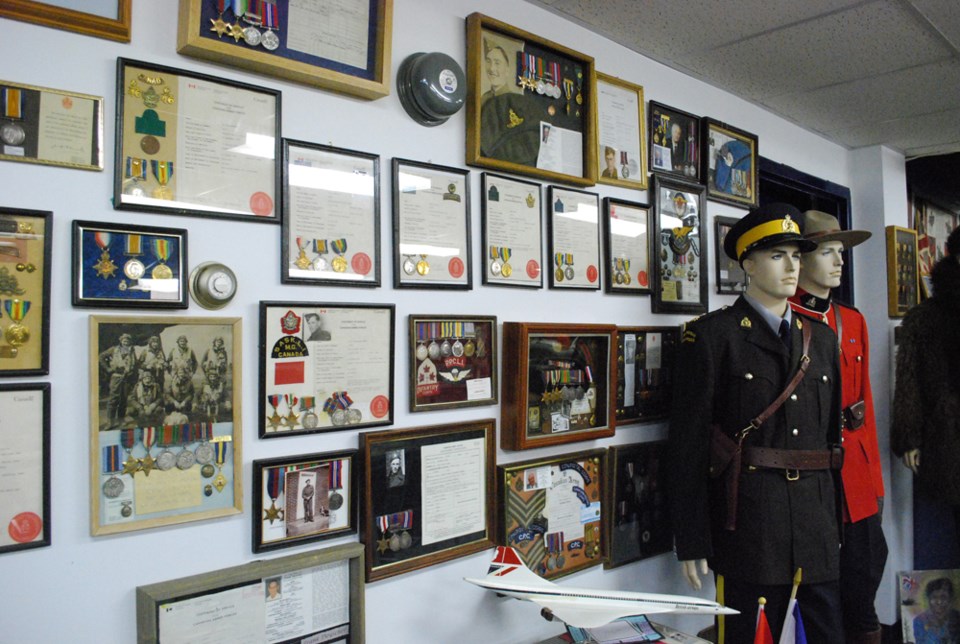The War Museum in the basement of the Royal Canadian Legion #28 in Humboldt is an extensive collection of war artifacts.
So how did it get so big?
Reverend Al Hingley says it is simply because of his big mouth.
Legion #28 provides the space and pays for the utilities but for the rest, the museum is dependant on fundraising and talking to people.
“My modus operandi is if you don’t ask for something, people don’t know you could use it. And if you ask and they’re not willing to free it up, you haven’t lost anything because you didn’t have it to begin with.”
War artifacts are now 2-3 generations from point of receiving it, says Hingley, so the significance is missing but the importance is still there. Sometimes it is a matter of the family not knowing what to do with it and it taking up space, says Hingley.
By having a place to donate the pieces into the collection, people know these artifacts will be enjoyed by all and taken care of in the process.
“By letting people know we’re here and we welcome the stuff, we’ll give it a good home and hold it in public trust, it gets freed up.”
Hingley’s main source of items is by donation but if there is the opportunity to purchase items for the museum that they need, for example, to complete a set of something, Hingley will take it, he says.
Even just by entering the room, visitors cannot gauge the extent of the Humboldt collection.
Around every corner holds more war memorabilia for visitors to explore.
Numerous uniform covered mannequins welcome visitors. Along one wall, floor to ceiling cabinets display everything from rifles to badges.
Display cases fill the centre of the room with knives, bayonets, compasses, and other smaller pieces on display.
A German mouth organ sits alone on a glass shelf. It was given to the collection by Weislawa Gutek, given to her mother by a German soldier. When Poland was occupied, German soldiers billeted with Polish families. This was his thank you to Gutek’s family when he left to fight in Russia.
A display case at the back of the room holds German artifacts donated by Hingley’s benefactor, Byron Von Bryce, including luger pistols brought back from WWII and Nazi pins, metals and a first aid kit.
Hingley is the one responsible for getting the armored troop carrier in the Legion parking lot. All that took was a letter of request to then Minister of Defense, Peter McKay, who is from the same county in Nova Scotia as Hingley, and a semi trip from Dundurn to Humboldt.
The gun that sits on top of the carrier took another request to McKay and a trip to Dundurn for Hingley. That is set up down in the museum.
Hingley says, McKay got his revenge on him since Hingley had to go through much training and paperwork in care of the transport because it belongs to North Atlantic Treaty Organization.
Hingley himself has a few personal mementos in with the collection, including a postcard from his cousin who was a prisoner of war in Germany as a member of the North Nova Scotia Highlanders.
Hingley’s ties to Nova Scotia brings a different dimension to the collection. He has a special section dedicated to Nova Scotia’s ties to the world wars, including drawers of Nova Scotia regimental badges and insignias.
Hingley finds the nurses uniforms an interesting part of the collection. Fewer women served compared to men, so there were fewer opportunities to acquire them. Another reason the uniforms are so scarce to acquire is that they were repurposed for civilian wear after the war was over.
Hingley recalls a woman telling him that her mother took her uniforms, redesigned them for civilian wear and set them to help German family members who had nothing.
“I thought that was unique,” says Hingley, “here’s a uniform that was used by a person who was theorically against another group. And yet when it was all over, the uniform was made into something of use for them.”
As well as aboriginal carved stone tools and arrowheads, the Humboldt collection also has some pieces dating back to the Boer War in 1899-1902 and trench art from World War I.
“These guys sat in the trenches for days doing nothing, so the artistic, creative ones made letter openers...and hooks for pocket watches.”
Hingley considers it an honour and privelge to volunteer with the legion to take care of the museum and especially would like to thank his legion comrades who work to keep the museum open. Hingley would also like to thank those who contribute to it.
The museum is not open all the time but Hingley says, all it takes is a phone call.
“Because I’m a staff of three; me, myself and I...we can’t be open all the time but people without hesitation just need to call me and we’ll come down here and we’ll share the museum.”




